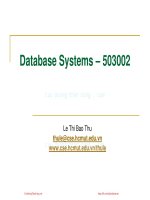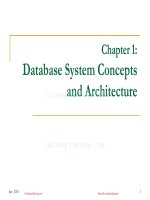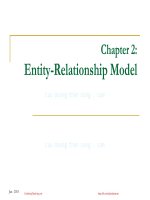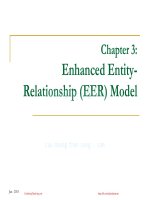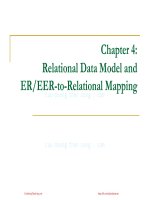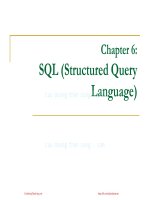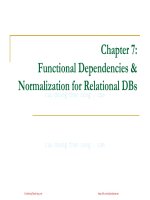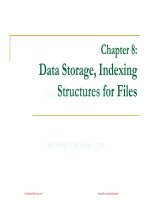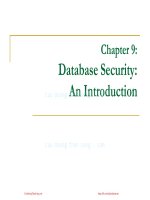cơ sở dữ liệu lê thị bảo thu chương ter c0 overview of a dbms sinhvienzone com
Bạn đang xem bản rút gọn của tài liệu. Xem và tải ngay bản đầy đủ của tài liệu tại đây (537.96 KB, 17 trang )
Course:
Database Management Systems
Lê Thị Bảo Thu
www.cse.hcmut.edu.vn/thule
CuuDuongThanCong.com
/>
1
Contact information
Lê Thị Bảo Thu
Email:
Website:
www.cse.hcmut.edu.vn/thule
CuuDuongThanCong.com
/>
2
References
[1] R. Elmasri & S.B. Navathe (2011).
Fundamentals of Database Systems, 6th
Edition, Addison-Wesley
[2] H. G. Molina, J. D. Ullman, J. Widom, Database
System Implementation, Prentice-Hall, 2000.
[3] H. G. Molina, J. D. Ullman, J. Widom, Database
Systems: The Complete Book, Prentice-Hall,
2002
[4] A. Silberschatz, H. F. Korth, S. Sudarshan,
Database System Concepts –3rd Edition,
McGraw-Hill, 1999.
CuuDuongThanCong.com
/>
3
References
[1] R. Elmasri & S.B. Navathe (2011).
Fundamentals of Database Systems, 6th
Edition, Addison-Wesley
[2] H. G. Molina, J. D. Ullman, J. Widom, Database
System Implementation, Prentice-Hall, 2000.
[3] H. G. Molina, J. D. Ullman, J. Widom, Database
Systems: The Complete Book, Prentice-Hall,
2002
[4] A. Silberschatz, H. F. Korth, S. Sudarshan,
Database System Concepts –3rd Edition,
McGraw-Hill, 1999.
CuuDuongThanCong.com
/>
4
Course outline
C0. Overview of a DBMS
C1. Disk Storage, Basic File Structures, and Hashing
C2. Indexing Structures for Files
C3. Algorithms for Query Processing and Optimization
C4. Introduction to Transaction Processing Concepts
and Theory
C5. Concurrency Control Techniques
C6. Database Recovery Techniques
CuuDuongThanCong.com
/>
5
Course outline - Timetable
C0. Overview of a DBMS (w. 1)
C1. Disk Storage, Basic File Structures, and Hashing
(w. 1, 2)
C2. Indexing Structures for Files (w. 3, 4, 5) – Test 1
C3. Algorithms for Query Processing and Optimization
(w. 6, 7, 8) – Test 2
C4. Introduction to Transaction Processing Concepts
and Theory (w. 9, 10)
C5. Concurrency Control Techniques (w. 11, 12) –
Test 3
C6. Database Recovery Techniques (w. 13, 14)
CuuDuongThanCong.com
/>
6
Three parts
Storage management: how secondary storage is
used effectively to hold data and allow it to be
accessed quickly
Query processing: how queries expressed in a
very high-level language such as SQL can be
executed efficiently
Transaction management: how to support
transactions.
CuuDuongThanCong.com
/>
7
Assignments
File structure
Oracle
MySQL
Query Processing
PostgreSQL
Big Data
Oracle
MS SQL Server
CuuDuongThanCong.com
Oracle
Object-relational DBMS
Oracle
MS SQL Server
Distributed DBMS
Oracle
MS SQL Server
Recovery
Cache
Index in Oracle
R-Tree/ Hilbert R-Tree
Bitmap index
Transaction
Oracle
MS SQL Server
Index
MongoDB
Hadoop
/>
8
Assessment
Midterm: 50%
Preliminary tests in class: 30%
Test 1 (c. 1 + 2; w. 5): 10%
Test 2 (c. 3; w. 8): 10%
Test 3 (c. 4 + 5; w. 12): 10%
Assignment: 20%
Deadline for assignment submission: w. 15
Final exam: 50%
multi-choice & written.
Reviews: c. 0-6
CuuDuongThanCong.com
/>
9
Course: Database Management Systems
Chapter 0
An Overview of a Database
Management System
CuuDuongThanCong.com
/>
10
What is a DBMS?
The power of database comes from a body of
knowledge and technology that has developed over
several decades and is embodied in a specialized
software called a database management system,
or DBMS.
A DBMS is a powerful tool for creating and
managing large amount of data efficiently and
allowing it to persist over long periods of time safely.
CuuDuongThanCong.com
/>
11
DBMS Capabilities
The capabilities that a DBMS provides the user are:
Persistent Storage. A DBMS supports the storage of very large
amounts of data that exists independently of any processes that
are using the data.
Programming Interface. A DBMS allows the user to access and
modify data through a powerful query language.
Transaction management. A DBMS supports concurrent
access to data, i.e., simultaneously access by many distinct
processes (called transaction) at once. To avoid some of the
undesirable consequences of simultaneous access, the DBMS
supports:
isolation
atomicity
resiliency
CuuDuongThanCong.com
/>
12
History of database systems and DBMS
1960s: FlatFile,
Hierarchical,
Network
Databases.
1970s:
Relational
DBMS –
RDBMS)
CuuDuongThanCong.com
1980s:
ObjectOriented,
Distributed
DBMS
1990s:
Objectrelational
model) –
ORDBMS,
OLAP, data
mining, data
warehouse,
multimedia
DB
2000s: XML DB,
bioinformation,
data stream,
sensor network,
NoSQL
/>
CuuDuongThanCong.com
/>
14
The Database System Environment (1)
DBMS component modules
Buffer management
Stored data manager
DDL compiler
Interactive query interface
•
•
Query compiler
Query optimizer
Precompiler
CuuDuongThanCong.com
/>
The Database System Environment (2)
DBMS component modules
Runtime database processor
System catalog
Concurrency control system
Backup and recovery system
CuuDuongThanCong.com
/>
(Relational) DBMSs in Practice
MySQL
Oracle
MS SQL Server
IBM DB2
…
CuuDuongThanCong.com
/>
17
